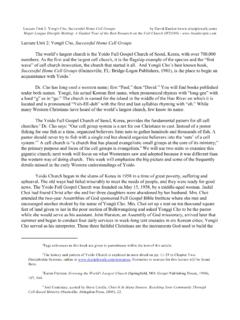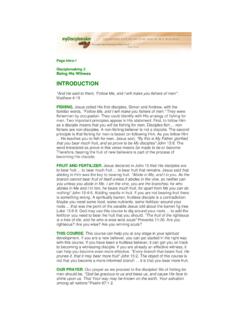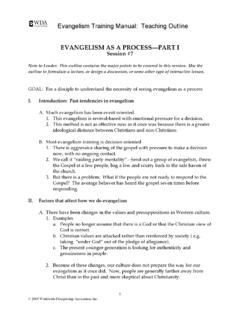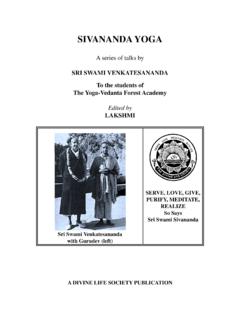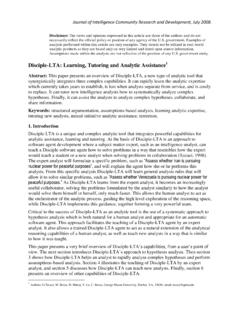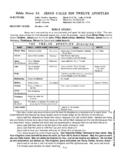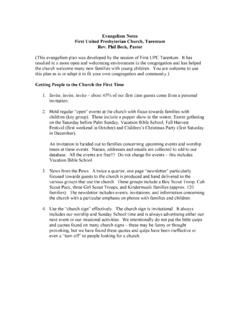Transcription of The Problems of Non-Denominationalism - …
1 The Problems of Non-Denominationalism H Bruce Stokes, PhD HBStokes 2011 All Rights Reserved Page 1 Non-denominational Christianity is a rather recent phenomenon in Christian History. It is a result of three influences on the foundation of American individualism Evangelicalism, the Para-Church movement, and the Charismatic movement. This essay will address the Problems of Non-Denominationalism and the need for Christians to move away from this problematic approach to faith and practice. The history of Judeo-Christianity is a history of traditions. The faith of the apostles was based on, and continuous with, the Temple Judaisms of the first century. Called Judaisms rather than Judaism, because the religious traditions of the second temple period were divided into significant sects such as Pharisees, Sadducees, Essenes, Samaritans and disciples of John the Baptist and Yeshua (Jesus).
2 These proto-denominations each had a faith, practice and community that informed the members of that sect with respect to Scripture, Tradition, and relating to God that connected them within their sect and the other communities within Temple Judaism. When the teachings of Jesus (Yeshua) and the apostles formed communities, the faith and practice of the disciples of Jesus also developed into additional sects. Though all of them are not identifiable, it is clear that differences existed in the faith as practiced by Jewish believers, Gentile believers, and those living in the Land with access to the Temple and those in the Diaspora with less access to the Temple. After the loss of the Temple, both Judaism and the emerging Christian traditions had to reform their understanding of worship and community life in a Diaspora context within the Roman Empire.
3 In addition to the growing separation between the transitioning rabbinic Judaism, a multi-linguistic and cultural Christianity was developing. Greek, Latin, Coptic languages and doctrine variation based groupings struggled to express the faith. Five centers formed Jerusalem, Antioch, Alexandria, Rome and Constantinople and each became a major religious hub and managed the faith, practice and community systems for Christians. Christianity held together for the most part but significant tradition distinctions existed. The split with rabbinic Judaism was followed by a separation by the oriental Churches (called Oriental Orthodox). In 1050AD, the Eastern Orthodox Churches and the Roman Church separated.
4 In the Reformation and counter-Reformation the Roman Church split further creating the Protestant Denominations and the Free Churches which functioned as smaller sects within the Western tradition. Each denomination struggled with the Biblical Texts, the Common Tradition, and their own perspective as Christians became denominational. While some of the variances were severe and at times the various Christians rejected each other as authentic believers, one can view the denominations as variations on a theme or as monetary denominations like a one dollar, five dollar, and ten dollar bill. Each is authentic but the value is different. In this case, it was their value in representing the truth and faith of the apostles that is at issue.
5 The Problems of Non-Denominationalism H Bruce Stokes, PhD HBStokes 2011 All Rights Reserved Page 2 The Road to Non-Denominationalism In America, the Protestant denominations had to operate in competition with the Free Church denominations because of the absence of a State sanctioned Church, common in Europe. This created a more egalitarian influence upon American Christians who connected to their denominational preference with less coercion. The basic American individualism set a background for this. Three movements pushed the American Christians toward a more non-denominational approach to faith and practice. These were Evangelicalism, the Para-Church movement, and the Charismatic movement.
6 Each of these movements, separately and together, ties to individualism inherent in American culture to move Christians away from a stricter denominationalism . The Evangelical movement grew out of the Fundamentalist Modernist controversy brought about by modern science and the emerging Behavioral Sciences of anthropology, sociology and psychology. Darwin, Marx, and Freud (among others) presented a challenge to the traditional religious world view of the Greco-Roman Judeo-Christian amalgam of Western Civilization in its various linguistic and national cultural forms. The American churches had to address this change in world view. They divided into two camps, Fundamentalists, who sought to hold the traditional world view and Modernists, who sought to accommodate the scientific perspective within the faith.
7 The Modernists won the protestant denominations and this so-called liberalism further removed their appeal to a religious populous in America. In response and reaction to the liberal shift, the Evangelical movement moved through the denominations giving a personal faith to many traditional Christians who wished to retain their denominational context. Most of the Free Church denominations moved into the Fundamentalist camp. The Fundamentalist Modernist split was complicated further by a split among the Fundamentalist and Evangelicals. This was less over doctrine than behavior. Fundamentalists and Evangelicals believe quite alike. But Fundamentalists avoided drinking, dancing, movies and any so-called worldly behavior.
8 Evangelicals were more moderate in these things and engaged in some levels of these behaviors, privately if not publically. While Fundamentalists isolated themselves from the world, Evangelicals sought to reach the non-churched and this was the impetus for the Para-Church movement. Para-Church organizations became the evangelistic arm of the Free Churches and the evangelicals among the traditional denominations. Gideons, Youth for Christ, Navigators etc. formed outside of the denominational clash to make an impact on the unchurched and special age and interest groups. Many who joined or were converted within these groups saw the congregation as important but not essential to Christian development and ministry.
9 These para-churches were non-denominational (not under any existing denomination) and could cooperate with various Christian denominational traditions. One s age and ministry interest dictated which para-church organization one supported. The Problems of Non-Denominationalism H Bruce Stokes, PhD HBStokes 2011 All Rights Reserved Page 3 This fragmented denominationalism further. Free Churches connected well with the para-church organizations and many organizations connected converts to the church for discipleship. The non-denominational mind set was now within free churches (Baptists, Free Methodists, Evangelical Free, etc.) and evangelistic zeal was the primary focus of Christians in this context.
10 Pentecostalism had isolated itself as a movement and produced its own denominations (Foursquare, Assemblies of God, among others) and prior to the 1950 s animosity between Pentecostals and non-Pentecostals kept these churches separated. But during the 60 s a modified form of Pentecostalism emerged. The Charismatic movement entered traditional denominations - Catholic and Protestant, Free Church and in some cases among Fundamentalists. The Jesus movement , with its anti-establishment mindset resident in the baby-boomers, made Jesus cool and house churches formed without denominational connections. Calvary Chapel, the Vineyard, and Melodyland Christian Center created models of churches that were denominational lite at best.


